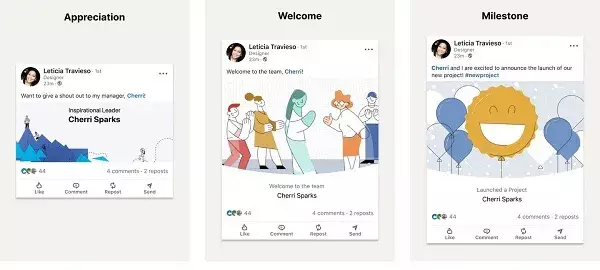LinkedIn has recently made significant changes to its platform by announcing the removal of various templated posts, specifically the celebratory post types accompanied by animated graphics. This decision has been communicated to users who have utilized these templates in the past, indicating that nearly all of these options are being phased out. Currently, it appears that only the confetti template will remain, suggesting a concerted effort by LinkedIn to move away from this particular visual style.
The communication from LinkedIn, attributed to Ahmed Ghanem, conveyed that templates such as Appreciation, Welcome, and Skill Assessment Badge are among those that will no longer be available. While this may seem like a minor tweak to the platform’s functionalities, it reveals a deeper strategy aimed at encouraging user engagement through original content. The emphasis on individuality in professional achievements could foster a more authentic sharing experience among its members.
Removing these generic templates paves the way for a more personalized approach to content creation. Users are encouraged to celebrate milestones and accomplishments with unique text, images, and videos. This move may come as good news for users who have grown weary of the repetitiveness of templated posts, which can sometimes dilute the impact of genuine achievements within a vibrant professional network.
Although some users may lament the loss of these stylistic elements, the shift could ultimately enhance the quality of posts on LinkedIn. By fostering an environment where originality thrives, LinkedIn is likely aiming to cultivate a community that resonates more strongly with authenticity over superficiality. The previous templated posts may have served a purpose, but as the platform evolves, so too must the way in which users engage and share their narratives.
The Shift to Video and Generative AI
Interestingly, LinkedIn’s decision is also reflective of broader trends in social media, where video is king. With many platforms leveraging this format to enhance engagement, LinkedIn’s alignment with this trend suggests a strategic pivot to facilitate more dynamic content. Encouraging users to create original visuals aligns with the professional network’s objectives of promoting personal branding and storytelling in the business realm.
Additionally, given LinkedIn’s growing interest in generative AI, many speculate that the platform may soon introduce features allowing users to create customized backgrounds or templates tailored to individual posts. This could lead to a fusion of style and substance, where members can visually express their professional journeys without relying on outdated templates. However, without a clear timeline or details, this remains conjecture for now.
LinkedIn’s decision to phase out templated posts signals a pivotal shift in how professionals will share their accomplishments and engage with one another. While some may miss the familiar graphics, the emphasis on authenticity and originality is likely an optimistic progression for the platform. As users adapt to these changes and discover new ways to express their professional narratives, it will be exciting to observe how this transformation unfolds. LinkedIn’s evolving strategy appears to be not just about aesthetics but about fostering a more engaged and authentic professional community.


Leave a Reply